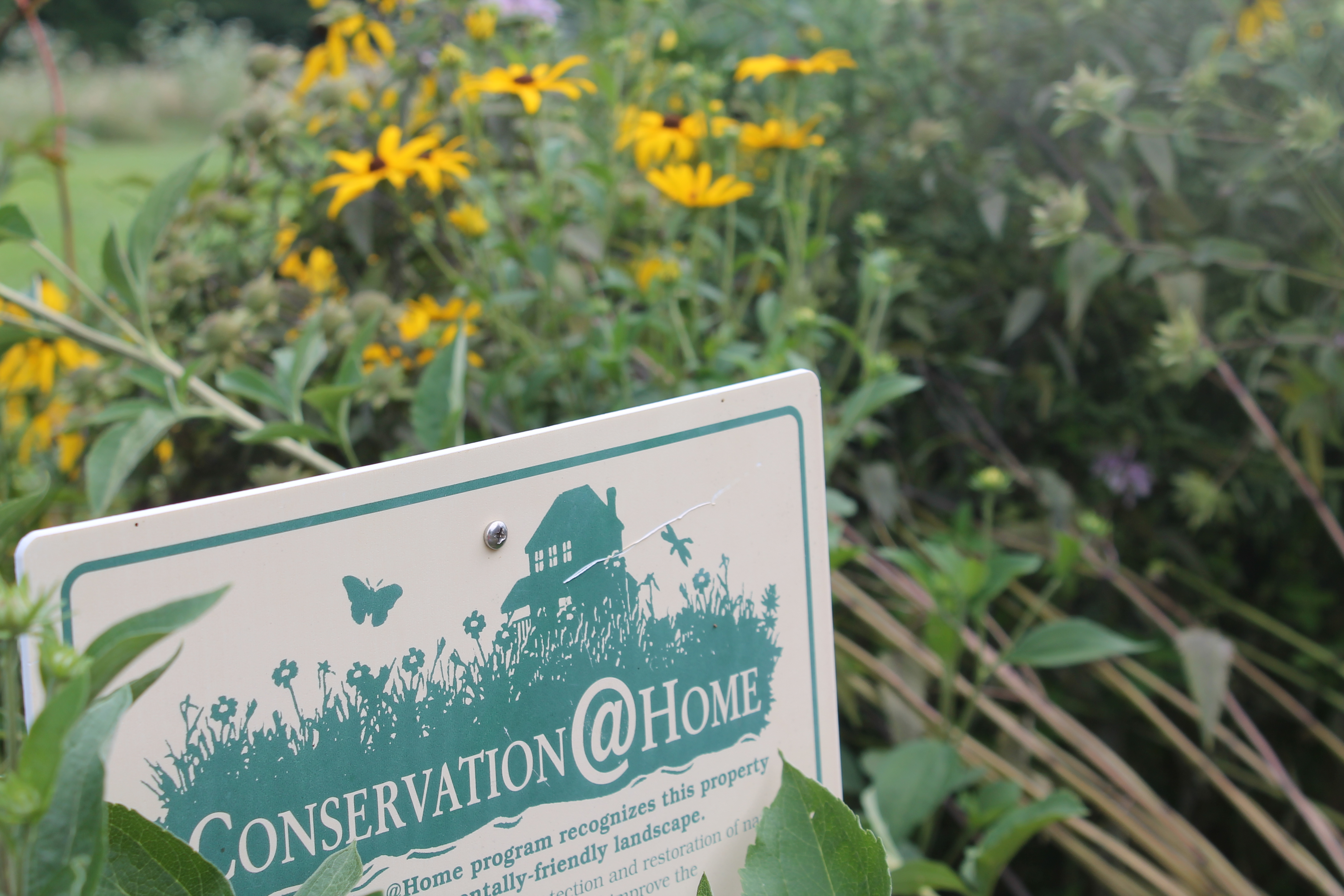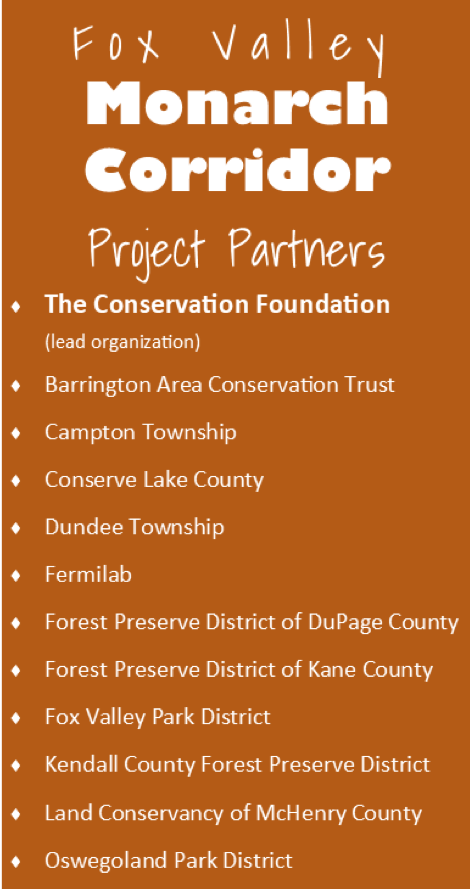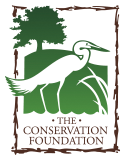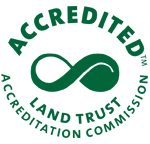Conservation@Home Regional Partnerships
Conservation
@Home Regional Partnerships
Thanks to the overwhelming success of the Conservation@Home program over the last five years, several other conservation groups in the region are helping promote the program outside of The Conservation Foundation’s service area of DuPage, Kane, Kendall, and Will counties.
Learn more on your county:
- Lake County
- McHenry County
- Barrington area
- Cook County
- Winnebago, Boone, Stephenson, Ogle, or Northern DeKalb County
For all other areas, contact Jim Kleinwachter at 630-428-4500, Ext. 115 or email him.

CHICAGO LIVING CORRIDORS
The native plant movement really has been growing over the last 10 to 15 years; all the evidence points to it, with native plant nurseries reporting increasing sales and demand for catalogs and native plant sales expanding substantially. Natives are much more mainstream than they were 15 years ago.
With homeowners, corporations, and municipalities more frequently planting natives and getting certified through our Conservation@Home and Conservation@Work programs, as well as having several other regional organizations adopt these programs, it was really feeling like a map of all certified locations would be really useful. Mapping is key to demonstrating the locations of existing native habitat, telling us how much is already in place, where there are gaps, etc.
Chicago Living Corridors (CLC) was founded with this objective in 2015. Its mission is to promote the idea that private landowners can be instruments of change by creating smaller natural landscape corridors between larger protected conservation areas, and that these corridors will improve wildlife habitat, water quality and diminish the effects of climate change.
CLC became an affiliate organization under The Conservation Foundation’s banner in the fall of 2018. With this arrangement, we are now expanding the map CLC created to add our existing sites with improved habitat and new sites as their habitat is improved and assessed.
The goal of the CLS’s founders was to showcase existing and new programs
in the Chicago area for assessing and improving habitat on private property.
Representatives from our Conservation@Home program, Citizens for Conservation’s Habitat Corridors, McHenry County’s Wildflower Propagation and Preservation Committee’s (WPPC) Mentoring Program and West Cook and Northern Kane County Wild Ones chapters’ outreach provided leadership. They were particularly focused on developing a comprehensive area map to show the “corridors” of improved habitat, and the possibility of expanding it in the greater Chicago area.
Volunteers created a website and a map which is populated with dots representing private properties that have incorporated the use of native plants and earth-friendly yard practices. Different organizations are indicated by colors representing the various organizations’ programs (the bright red dots are those certified through The Conservation Foundation). An additional emphasis on the website is useful resources for individuals who are interested in creating better habitat on their own properties. There has been much interest expressed by other organizations in the Chicago area with similar goals.
This mapping information is so helpful in knowing where linkages can be created between pockets of habitat. Plus, it’s just pretty cool to see the impact of these programs as they grow and spread across the landscape! We’re honored to be partnered with Chicago Living Corridors.
Message from The CLC
Board of directors
 CLC fills a void because it concentrates on the privately-owned native habitat (or gardens), which is an element that hasn’t been covered by other projects. The specific target is these unprotected, but natural, properties that provide connection between the larger protected lands. The focus of many other initiatives is on the protected properties (i.e. parks and forest preserves). Much of the future of native plants and wildlife depends on recruiting private property owners and linking these “stepping stone” habitats with the larger restored habitats on public and privately-owned properties. CLC intends to continue to promote improved habitat on private land in the Chicago area and maintain the chicagolivingcorridors.org website, knowing that as a joint effort we can expand the corridors and awareness of need for native pants, and have greater impact.
CLC fills a void because it concentrates on the privately-owned native habitat (or gardens), which is an element that hasn’t been covered by other projects. The specific target is these unprotected, but natural, properties that provide connection between the larger protected lands. The focus of many other initiatives is on the protected properties (i.e. parks and forest preserves). Much of the future of native plants and wildlife depends on recruiting private property owners and linking these “stepping stone” habitats with the larger restored habitats on public and privately-owned properties. CLC intends to continue to promote improved habitat on private land in the Chicago area and maintain the chicagolivingcorridors.org website, knowing that as a joint effort we can expand the corridors and awareness of need for native pants, and have greater impact.Dupage monarch project
The DuPage Monarch Project is a group of local organizations working together to provide education about monarchs and increase the amount of suitable monarch habitat throughout DuPage County. DuPage Monarch Project is asking mayors and village boards to formally resolve to make their communities more monarch friendly.
Partners in the DuPage Monarch Project are the Forest Preserve District of DuPage County, Sierra Club River Prairie Group, The Conservation Foundation, and Wild Ones Greater DuPage Chapter.
This group has created sample resolutions that communities can pass to become more monarch-friendly as well as a list of suggestions for community improvement and engagement in monarch conservation, and presentations that can be given to government councils and citizen groups on the monarch crisis and what they can do to help.
The Conservation Foundation is proud to be a partner in this local effort to help our imperiled monarchs! Learn more and find sample resolutions and other ideas!
Fox Valley monarch Corridor Project
A $250,000 grant from the US Fish & Wildlife Service allowed us to bring together 11 other local public and private agencies in an historic partnership called the Fox Valley Monarch Corridor Project. Together we are spent two years carrying out the Fox Valley Monarch Corridor Project, aimed at preserving and restoring existing monarch habitat, creating additional habitat and getting more milkweed on the landscape along the Fox River.
What is the Fox Valley Monarch Corridor?
The Fox Valley Monarch Corridor extends over 975 acres and includes the establishment and restoration of 10 multi-acre natural areas and hundreds of “stepping stone” sites on private land that will connect the breeding and migration habitats of monarch butterflies and other pollinators.


Why It’s Not All About Big Natural Areas
While these larger natural areas are obviously key, another vital component of our effort is linking the bigger tracts together through the creation of pockets of habitat. That’s what The Conservation Foundation’s Conservation@Home and Conservation@Work programs are all about. We’re working diligently to engage more residents, business owners and organizations in these programs by encouraging them to use native plants, reduce their mowing, watering and chemical use, and especially to plant milkweed! Milkweed is essential for monarch survival as their main food source and where they lay eggs.
How You Can Help Monarchs and Other Pollinator Species
Planting milkweed and other native plants in our yards is one of the biggest ways we can give these species a helping hand. If you need some assistance, we are here for you! And if you are already using a lot of sustainable landscaping practices, you deserve to be recognized for your efforts through Conservation@Home or Conservation@Work certification.
Visit our Conservation@Home getting started page as a great jumping off point or call us today with questions or to schedule a home visit at (630) 428-4500.
“We’re very happy to bring all these organizations together to do such important work,” says Dan Lobbes, our Director of Land Preservation and Project Manager of the Fox Valley Monarch Corridor Project. “It takes all of us working together to make a significant, lasting difference for the monarchs and for us all.”

Oak Recovery Initiative
The Conservation Foundation is a proud participant in the Chicago Region Trees Initiative. Along with more than 160 partner organizations, we are striving to make the Chicago region the greenest, most livable, and most resilient region in North America, and we believe that trees are critical to achieving this vision.
“The mission of the Chicago Region Trees Initiative is to make a significant and measurable improvement to the Chicago region’s tree canopy, but we can’t accomplish this goal without partners like The Conservation Foundation,” said Lydia Scott, director, CRTI. “CRTI is proud of The Conservation Foundation as a leader in protecting and caring for our region’s trees, enhancing the quality of life for our region’s residents.”
We have taken the lead on landowner outreach about oaks in Kane and Kendall counties along the Big and Little Rock Creeks, as well as organizing community oak workshops, lectures and tours of private lands where oak woodlands have been restored.
Encouraging Community Participation
As a way to get more oaks planted on our suburban landscape, volunteers have converted the old chicken yard at our McDonald Farm headquarters in Naperville into a tree nursery complete with an irrigation system (which were also paid for and installed by a volunteer!) Each spring, an anonymous donor purchases 130 native oaks in 5-gallon buckets for the tree nursery. Each tree, in the bucket, is placed in a hole with an individual drip irrigation source. This (extraordinary) volunteer maintains the nursery and trees throughout the year. During the year, mostly in spring and fall, we distribute all of these trees to Conservation@Home/Work participants, volunteers, schools, churches, parks and other areas. These are provided free of charge to deserving and appropriate landowners who can demonstrate they will plant them in the right place and take care of them. Information about how to properly plant and care for oaks is included.
To encourage community participation in the fall for “Oaktober,” we have also received several hundred oak trees from our friends at Bartlett Tree Experts and uses them as part of our Mighty Acorns® programs throughout the region, educating kids about the importance of oaks and trees in our landscape. Many of these oaks end up in parks and forest preserves, in addition to school grounds. Over the past three years, we have distributed more than 1,200 oak trees!
Our efforts in oak recovery were generously recognized by the Chicago Region Trees Initiative with a Forestry Outreach Award in 2018, stating The Conservation Foundation earned the honor through “its efforts in preserving, restoring land and coordinating the Conservation@Home program in Northeast Illinois, and for considerable work on oak tree establishment and private landowner outreach in the Big Rock Creek watershed.”
“Participating in the Chicago Region Trees Initiative and the oak recovery efforts is a natural fit for us,” said our President/CEO Brook McDonald. “It furthers our efforts to collaborate in a way that helps improve local natural areas and wildlife habitat, clean up our water and air, and engage people where they live in ways that are meaningful to them.”
We remain committed to supporting the Chicago Region Trees Initiative and the Oak Recovery Initiative to ensure that our native woodlands are healthy and productive for future generations.


